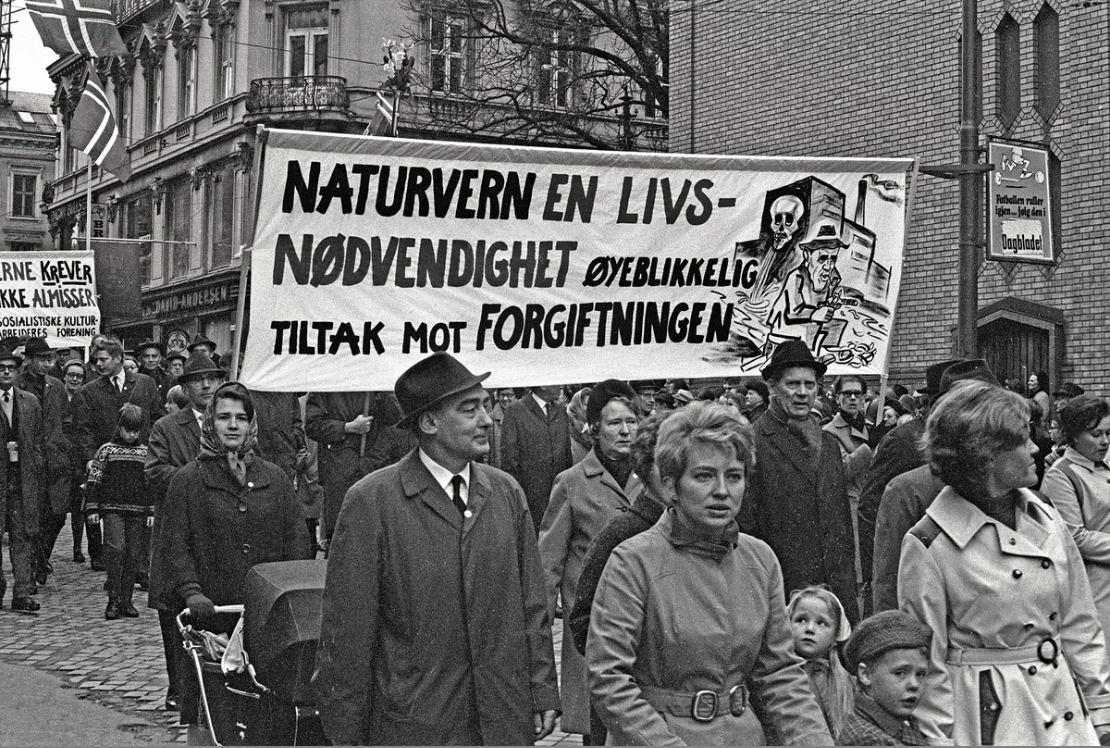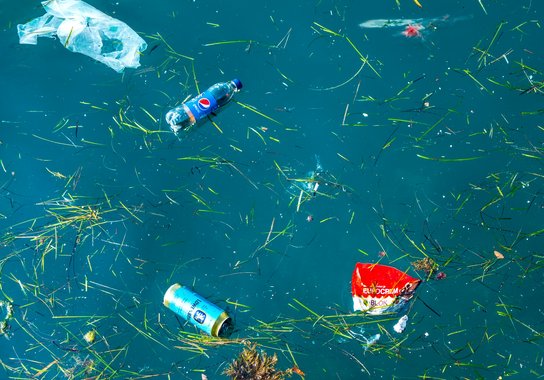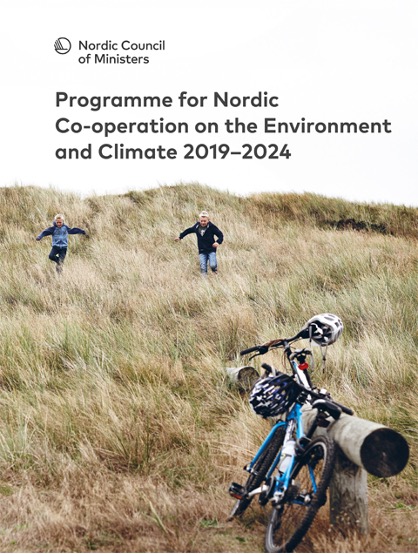The emergence of Nordic environmental cooperation, 1967-1974
Today the environment is a key policy issue of institutionalised Nordic cooperation. Yet it was only in the late 1960s that the environment emerged on the Nordic agenda. Its emergence was influenced by the so-called ‘ecological turn’ at the time, but economic considerations were by far the most decisive. Firstly, policy-makers were concerned that the introduction of environmentally-friendly measures may hit them where it hurt: They would be likely to create an economic deficit at a time when increased integration was the main focus - with its associated removal of trade barriers - be it at the Nordic or European level. Secondly, it made practical and economic sense to work together on complex and costly scientific research and decision-making to do with the environment. Ultimately, the Nordic Environmental Protection Convention signed in 1974 was the first international environmental treaty that implemented the polluter-pays principle for transboundary pollution.

By the late 1960s, decades of growth during the ‘golden age’ of the welfare state in the post-war era had improved living standards and helped build social security systems across the Nordic countries. Economic progress had changed consumer habits, single-use packaging reached modern supermarkets, and the number of home appliances per household increased, as did private mobility. This led to Nordic people coming face to face with pollution and litter more regularly on trips to lakes and forests, for example.
Influenced by the emerging debate about pesticides in the US (sparked by the book Silent Spring by marine biologist Rachel Carson in 1962) and the mercury-debate in mid-1960s Sweden, public concern for and interest in environmental issues began to grow both in and outside the Nordics. Within the Nordic region, ecology and neo-Malthusian ideas about overpopulation and finite resources were also promoted by publications by Swedish diplomat Rolf Edberg and scientist Hans Palmstierna in 1966 and 1967, respectively. Parallel to mushrooming environmental organisations and movements which were successful in engaging and mobilising growing parts of society in support of ecology, nature conservation and environmental protection, international organisations, too, placed the environment firmly on the agenda. Examples include the UNESCO Biosphere Conference in Paris in 1968, the European Conservation Year in 1970, the UN Economic Commission for Europe’s conference on problems related to environment in 1971 and the UN Conference on the Human Environment in 1972.
However, rather than being a direct consequence of environmental disasters and growing international public unease, Nordic cooperation on environmental issues emerged largely as a consequence of societal and economic debates. It was in fact already in December 1966 that the Nordic Council starting planning for a conference on pollution which was to be held the following year - a process that took place in parallel with setting out an exclusively economic agenda for their annual Nordic Council session.

PICTURE: The two-week U.N. Conference on the Human Environment in 1972 called by the General Assembly with the aim of producing an international political consensus on ways of preserving and improving the environment for this and future generations met in Stockholm. Among others at the table are the authors of "Blue Print for Survival", Edward Goldsmith and Dr. Harman Daly. Photo: UN Photo/Yutaka Nagata.
The 1967 Nordic Conference on Soil and Water Pollution - A watershed
Even though the Nordic Council (which was founded in 1952) had discussed issues such as nature protection and marine pollution caused by oil dumping prior to 1967, the Nordic Conference on Soil and Water Pollution was the first to seize on the topic of the environment from an ecological and anthropocentric perspective. It was therefore a defining moment which kick-started Nordic environmental cooperation. Held in May 1967 on the island of Lidingö in the Stockholm archipelago, the conference gathered more than 170 representatives from authorities, ministries and governments, scientific research, industry, agriculture, and nature protection organisations in order to discuss two main aspects:
- The existing knowledge on chemicals, with a particular focus on their harmful impact on humans and the economy.
- The potential areas of cooperation on environmental pollution.
However, the emergence of the environment as a policy issue within Nordic cooperation has to be seen in the context of the overriding debate which was concerned with increasing economic integration and the removal of trade barriers and international competition. Denmark, Norway and Sweden had been among the founding members of the European Free Trade Association (EFTA) in 1960 and there were on-going negotiations about whether a new organisation for Nordic economic cooperation should be set up. The idea of a 'NORDiskt EKonomiskt samarbete' (NORDEK) came to the fore after Charles de Gaulle’s second veto of the British EEC membership application in late 1967. In this context, the environment became a key consideration with respect to economic integration: Domestic environmental regulations and abatement policies might cause trade barriers and create difficulties within international economic competition, which in turn would negatively impact a country’s economic growth and tax revenues – namely, it would hit the income source that had essentially founded the Nordic social security systems and welfare states.
This dual concern, for environmental pollution and economic growth, led to intensified cooperation in the efforts to harmonise environmental legislation in the Nordics. At the same time, scientific research on the hazardous effects of chemicals had to be funded and existing environmental pollution needed to be combated. Nordic cooperation on these issues had obvious benefits; scientific cooperation could be used efficiently and duplication of research could be avoided, while joint research secured a common standard of knowledge that eventually defined regulations and fed into the process of environmental policy-making.
At the 1967 Nordic conference and during the negotiations for NORDEK in the years that followed, international economic competition continued to be decisively important, and likewise international cooperation was considered necessary for positive environmental change. Due to the similarity regarding the causes and effects of environmental pollution in the Nordic region and the on-going NORDEK negotiations, achieving Nordic environmental cooperation appeared to be realistic and more efficient than cooperation at the European level. This was particularly the case because the Nordics could build on traditions and experiences from previous and on-going cooperation on other policy issues.
Environmental policies: A chance for Nordic cooperation
When NORDEK plans failed in 1970 and Denmark and Norway applied for EC-membership, the environment was considered to be the policy issue that could fill the void left by failed economic cooperation. It could also reinforce Nordic cooperation by furthering national environmental policies through harmonised legislation and by strengthening Nordic cohesion at the international level through joint advancement of ideas and solutions.

PICTURE: In the late 1960s, with larger disposable incomes than before, people were more mobile and became more exposed to visible pollution in lakes and rivers, which helped to garner support for the environmental movement. Photo: Colourbox.
Following the 1967 Nordic Conference on Soil and Water Pollution, the institutionalisation of environmental cooperation in the Nordic Council and the Nordic Council of Ministers ran parallel to national reorganisations and the institutionalisation of environmental administration, agencies and ministries within the Nordic countries. Initiated by the Nordic Council's proposal on cooperation on pollution issues of 14 September 1967, politicians, officials and scientists discussed the administrative, legislative, scientific and political aspects and opportunities of such cooperation over the following two years.
In 1969, the Nordic Council’s Social Policy Committee recommended strengthening scientific cooperation, administrative cooperation, stimulation of environmental research and education in order to solidify scientific-based policy-making, scientific control of law enforcement, and – importantly – the setting up of a cross-sectoral committee of officials to monitor this process. These ideas had been proposed in a draft by Anders Åkerblom and Nils Mustelin on behalf of NordForsk, the Scandinavian Council for Applied Research which had been founded in 1947. The initial concern that environmental abatement regulations and pollution control might cause national economic deficits unless they were harmonised across borders remained prominent during the discussions in the Nordic Council. Nonetheless, the foundation for Nordic environmental cooperation within scientific research and legislation had been laid, and this led to two fundamental developments that still underpin Nordic environmental cooperation today:
- The mandate of the (then-called) Liaison Committee on Environmental Issues (Kontaktorgan för miljövårdsfrågor).
- The setting of key commitments down in law, namely, the Helsinki Treaty.
The Liaison Committee on Environmental Issues (Kontaktorgan för miljövårdsfrågor)
The Kontaktorgan was created at a meeting at the ministerial level in Stockholm on 14 December 1970 and the Kontaktorgan itself was composed of three representatives each from Denmark, Finland, Norway and Sweden: One of these represented the responsible ministry, one represented the central authority responsible for practical implementation, and one represented scientific research. Although Iceland, too, was granted representation, it stayed in the background during the first decades of Nordic environmental cooperation. The committee’s mandate included the general monitoring and promotion of environmental activities including:
- the implementation of Nordic Council recommendations;
- the facilitation and management of exchange of information and experiences; and,
- the coordination of research projects and activities in order to pool financial and scientific resources and avoid duplication of research.
In order to fulfil this mandate, the Kontaktorgan was authorised to call on experts and representatives of interest organisations, as well as to propose the creation of ad hoc working groups in which representatives of the Kontaktorgan as well as external experts could participate. Thus, the Kontaktorgan was the Nordic equivalent to a national environmental authority and functioned as a diffusion organ covering research, environmental monitoring, political advice, formulation of principles in environmental policies and of standards, placing of research projects, and collection of research and its dissemination.
With the creation of the Kontaktorgan in December 1970 and its first meeting on 25 February 1971 in Helsinki, Nordic environmental cooperation had seen both its institutional beginnings as well as establishing a co-production of science and politics. As part of the restructuring of Nordic cooperation following the failed NORDEK-negotiations and the creation of the Nordic Council of Ministers in 1971 and 1972, however, the Kontaktorgan was turned into a Committee of Senior Officials for Environmental Issues (Embedsmandskomite for miljøbeskyttelsesspørgsmål, EK-M/ÄK-M) in September 1973 and came under the auspices of the Nordic Council of Ministers/Environmental Ministers (MR-M).
With this change, Nordic cooperation established a parallel stream of political, bureaucratic and scientific cooperation. In practice, the EK-M continued the work of the Kontaktorgan in line with what was originally intended. The first Nordic Environmental Programme (agreed in 1972) addressed issues such as marine pollution of the Baltic Sea, the Sound, Skagerrak and Kattegat, waste treatment, noise pollution, environmental education, environmental research, a Nordic environmental protection convention, measures to reduce sulphur dioxide emission, air pollution caused by vehicle exhaust, nature protection and outdoor life (friluftsliv). Throughout the following years, Nordic environmental cooperation would be defined by similar five-year action programmes, the most recent one covering 2019 until 2024.
The environment enters the Helsinki Treaty
Key environmental principles were also set down in law in the 1970s. For example, the Nordic Environmental Protection Convention (NEPC), which was signed in 1974, was the first international environmental treaty that implemented the polluter-pays principle for transboundary pollution. In connection with this, the environment was also established in the Helsinki Treaty, which in 1962 had established the legal framework of institutionalised Nordic cooperation 10 years after the Nordic Council had been founded.
The environment - an essential area of Nordic cooperation
In 1974, the Nordic Council of Ministers successfully agreed on amendments to the Helsinki Treaty which established environmental cooperation as an essential area of Nordic cooperation next to legal, cultural, social, economic, and transport and communication cooperation. The three new articles (31-33) were based on the principle of non-discrimination and aimed at inter-regional standardisation and harmonisation of norms, regulations and prohibitions. This was to be achieved by close transnational cooperation among the various responsible Nordic agencies and ministries. More specifically, this meant that the Nordics should:
- “in their national legislation and in the application thereof […] to the greatest extent possible, place the environmental interest of the other High Contracting Parties on an equal footing with their own;”
- “seek to harmonise their environmental protection regulations so as to attain the greatest possible measure of agreement on standards and guidelines relating to pollution, the use of toxic substances that harm the environment, and other damaging effects on the environment;”
- “seek to co-ordinate matters relating to the allocation of nature reserves and recreational areas, and to protective initiatives and other measure for the conservation of flora and fauna.”
In contrast to the NEPC, which established a procedural system that was transferable to other forms of international cooperation, the Helsinki Treaty was not only directed towards the practical, continuous administrative work between the different responsible authorities and the mandate of the MR-M and the EK-M, but it also built on the established regional cooperation between the Nordic countries. The main intention with this revision was to explicitly strengthen Nordic environmental cooperation and to establish a legal framework in which to define specific norms and guidelines on environmental pollution - which in turn was seen as an essential basis of a possible separate convention, the NEPC.
Since the 1974 revision of the Helsinki Treaty, the environment has become one of the most prominent policy issues of Nordic cooperation. Today, the Nordic countries are generally considered to be ‘green’ nations with progressive environmental and climate policies. Within international policy-making, the Nordic countries propose solutions to global challenges; they promote green growth and climate change strategies, are active in the fight against microplastic pollution, as well as looking into the sustainable use of resources and nature protection. Yet, just as the initial emergence of environmental cooperation did not necessarily develop from purely ecological concerns, but rather from a concern about economic integration and cost allocation, environmental policies today serve economic interests to a significant degree, most vividly exemplified in the term ‘green growth’.

PICTURE: The Programme for Nordic Co-operation on the Environment and Climate 2019–2024 by the Nordic Council of Ministers published in 2018. Photo: Norden.org
This article is based on the research conducted in connection to the PhD dissertation ‘Green Internationalists: Nordic Environmental Cooperation, 1967-1988’.
Further reading:
- Andrew Jamison, Ron Eyerman, Jacqueline Cramer, and Jeppe Læssøe, The Making of the New Environmental Consciousness: A Comparative Study of the Environmental Movements in Sweden, Denmark and the Netherlands (Edinburgh: Edinburgh University Press, 1990).
- David Larsson Heidenblad, "Ett ekologiskt genombrott? Rolf Edbergs bok och det globala krismedvetandet i Skandinavien 1966," [An ecological breakthrough? Rolf Edberg’s book and the awareness of the global crisis in 1966 Scandinavia.] Historisk tidsskrift 95 (2016), pp. 245-266.
- Hallvard Notaker, "Staging Discord: Nordic Corporatism in the European Conservation Year 1970" Contemporary European History 29 (2020): 309-324.
- Melina Antonia Buns, "Da miljøpolitik blev nordisk," [When environmental policies turned Nordic] FORTID 1 (2018), pp. 81-89.